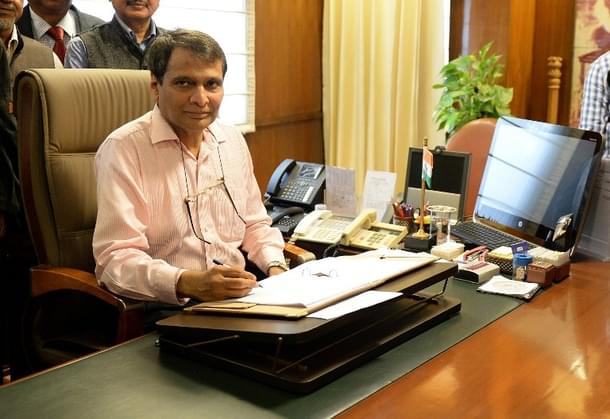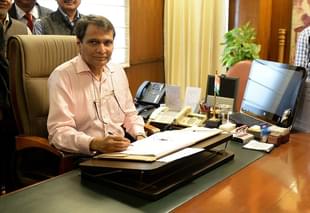Economy
A Sarkaari Rail Budget And The Perpetuity Of Indian Socialism
Praveen Patil
Feb 26, 2015, 10:40 PM | Updated Feb 19, 2016, 05:31 PM IST
Save & read from anywhere!
Bookmark stories for easy access on any device or the Swarajya app.


Railway budget did not reflect a break from past approaches
“But there is no dustbin here” said the young 6 year old boy whose tiny hands were clutching a host of multi-coloured wrappers of different variety, wrappers of chocolates and cookies and chips and all the goodies that he may have consumed over the last hour or so. “Ever since Modi uncle has started the Swachh Bharat campaign, Ani (Aniket, the 6 year old boy clutching the wrappers) never litters and waits to find a dustbin to relieve his waste” beamed his mother to fellow passengers.
We were all traveling in the dilapidated Margaon passenger train on the west coast of India and that young boy was among the 2.5 Cr Indians who regularly travel every day in some 11000 dirty trains operated by the Indian Railways. What was special about this train? No, not the torn seat covers or dirty windows or soiled toilets, but the fact that it was remarkably litter free. If you are a regular train traveler like me you would agree that Indian Railways are notorious for the amount of litter one comes across in the bogies.
There have been numerous advertisements right from the Doordarshan era educating people to consider Indian Railways as their own homes and to maintain a clean environment, but to no avail.
At least till recently, that is.
After more than 3 decades when I first set foot on a train and fell in love with Indian Railways (how could any Indian kid who grew up in the 80’s not have a rail tale to tell?), for the first time I found train bogies to be relatively cleaner this February in my travails on the west coast. In fact, 3 simple but remarkable transformations have come about in the Indian Railways in 2015:
– Discernibly cleaner and litter-free train bogies
– Special e-catering services by IRCTC which even offer a Domino’s Pizza in select stations of North India
Yet, these are all easy simplistic changes that the new Modi government has tried to bring about, for the challenges that Indian Railways face are far too many. Just before the budget today morning, Punya Prasun Bajpayi was conducting a debate on Aaj Tak where he was repeatedly asking his panelists, “Why is top notch infrastructure only provided to the rich who fly in planes and not to poor train travelers despite of the fact that very few people fly while in contrast the whole of India travels in trains?”

It is in this question that we find the catharsis for Indian Railways, Indian Socialism and Indian Entrepreneurship. Our inherent mindset, fed on a diet of Nehruvian socialism for decades, presupposes that any public good should be subsidized by the government in perpetuity. Thus, if air travel is used by only 2 lakh “rich” people every day and about 2.5 Crore “poor” Indians travel by train, then, socialism dictates that all air travelers must be burdened while train travelers must get cheap fares. Based on this principle train fares have been kept artificially low for decades which are then subsidized by other means.
In his budget today, the rail minister Suresh Prabhu once again unequivocally proclaimed that there would be no passenger fare hike and yet he announced that the operating margins would be much lower at 88.5 (operating margin being number of rupees spent to earn 100 rupees which would now be pegged at 88.5 rupees). The previous (2013-14) operating margin for Indian Railways was notionally 94 rupees which many economists argue is in reality at around 103 to 110 rupees (i.e. 103 to 110 rupees spent by Indian Railways to earn 100 rupees).
How would the rail minister then achieve 88.5 operating margins without increasing fares? Part of the solution was supposed to come from lower diesel prices which as per the Rail Budget is estimated at around 12000 to 15000 Cr savings in 2015-16. But then this begs the question of paring of benefits (at least partially) due to increased electricity prices. Thus there was no other alternative but to hike already stretched (beyond limits) freight prices which have been used historically by various governments as a political tool to subsidize passenger fares in the name of socialism. What does this increased freight cost mean in reality?
– Freight charges are already so high across the board that as per the Railway Minister’s own admission there is huge sub-optimal utilization of freight routes by Indian Railways which results in heavy losses every year
– Higher freight charges have forced many transporters to use roads and other means of transport which has meant that Indian Railways is losing freight traffic every year thus putting into doubt the minister’s own goal of increasing the annual freight carriage by Indian Railways from 1 billion tons to 1.5 billion tons in 5 years
– This is a regressive step towards the Make in India vision by the Prime Minister as it further increases cost of production and transportation in India (for instance, today it is cheaper to transport goods from Beijing to New York between continents than between two Indian cities Mumbai and Delhi. So why should anybody manufacture in India?)
– One of the commodities that has seen a huge freight hike is urea which has been increased by 10%. This essentially – means that the government which pays a whopping 75000 Cr subsidy every year for fertilizers will bear the extra cost. This in turn means government will indirectly subsidize Indian Railways beyond budgetary support
– This step is also nothing but convoluted socialism. An average train passenger may be happy today that he is not paying any extra fare, but the truth is that he will pay in a convoluted way to essentially subsidize himself! For instance coal freight has been hiked by 6% which means at some point of time electricity prices will increase which will be paid by the same train traveler to subsidize his own train travel – this is exactly the kind of never-ending socialist loop that Congress has cleverly created to keep India poor and sadly the Modi government is following the same!
Does all this cleverness mean that the Rail Budget of 2015 substantially reduces budgetary support? The answer is a resounding NO! This year too Indian Railways will get 40000 Cr rupees budgetary support from the finance ministry which essentially means that our trains cannot run on their own and would need support from the government. What is more, Indian Railways will need an additional 17665 Crore rupees of market borrowing beyond budgetary support. Thus the chances of Indian Railways turning profitable any time soon are almost near zero.
The fact that not once did the rail minister in his hour long speech even mention about turning Indian Railways into a profitable venture is disconcerting. It just tells us that Rail reforms are simply not on the agenda of this government. Last year at least there was some nominal talk of FDI in railways but this year nobody seems to be bothered to even utter the word privatization – maybe the Delhi electoral defeat has had a psychological impact far deeper than most of us expected.
Sadly, if BJP thinks it can win elections by giving freebies like the opposition parties, it will be in for a shock. The socialist electoral market is already overcrowded and BJP was voted mostly because of its differentiating factors – as evidenced by Modi’s electoral pitch in the summer of 2014 which was totally free of any goodies from free rice to free TV and instead talked about creating jobs and harnessing youth and transforming infrastructure. Does this Rail Budget live up to any of those Modi’s promises? Hardly any, I am afraid. To that extent the aggressive Dilli media and intellectual brigade seems to have put the Modi dispensation on the back foot by forcing their agenda on his government.
The hope of a civilization rests on this government. That young 6 year old boy who in his tiny hands was carrying all those wrappers in search of a dustbin in a moving passenger train to adhere to Modi’s Swachh Bharat revolution is the symbol of that hope. In 10 years, that boy would be 16. Would he have found his dustbin then? More importantly would the trains be substantially different from that dilapidated bogie of today when he turns 16? Looking at today’s rail budget such prospects look heavily unlikely. Will India have changed substantially in 10 years from its socialist dysfunctional present, if not the Indian Railways? We will know in 2 days’ time when Jaitley takes on the mantle from Prabhu… hope is eternal.
Analyst of Indian electoral politics and associated economics with a right-of-centre perspective.





